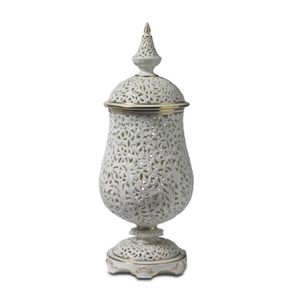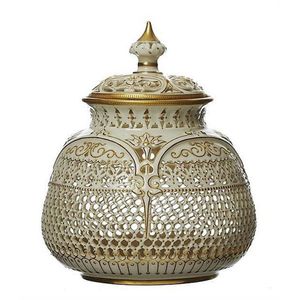Royal Worcester Jewelled Porcelain Vase with Cover
You must be a subscriber, and be logged in to view price and dealer details.
Subscribe Now to view actual auction price for this item
When you subscribe, you have the option of setting the currency in which to display prices to $Au, $US, $NZ or Stg.
- Incised - A record of a name, date or inscription, or a decoration scratched into a surface, usually of a glass or ceramic item with a blunt instrument to make a coarse indentation. Compare with engraving where the surface is cut with a sharp instrument such as a metal needle or rotating tool to achieve a fine indentation.
- Jewelled Decoration - Jewelled decoration on ceramics is a technique where small, colourful, and often metallic beads or "jewels" are applied to the surface of ceramic objects to create intricate and highly decorative designs. This technique has been used throughout history and across different cultures, but it was particularly popular during the late 19th and early 20th centuries, especially in Europe.
The jewelled decoration is usually applied by hand, one bead at a time, onto a base glaze or enamel. The beads can be made of glass, porcelain, or even precious stones, and are often set in a metal setting, such as gold or silver. The end result is a highly decorative and often luxurious surface, which can add a lot of visual interest and value to the ceramic object.
Jewelled decoration was used on a wide range of ceramic objects, including vases, plates, bowls, and figurines. It was particularly popular in the Art Nouveau and Art Deco periods, where it was used to create highly stylized and ornate designs. - Foliate - Decorated with leaves or leaf-like forms.
- Gilding - Gilding is a method of ornamentation whereby a thin sheet of gold metal is applied to items made of wood, leather, ceramics, glass and silver for decorative purposes.
For furniture including mirrors, the sheet of gold is usually applied over a coating of gesso. Gesso is a mixture of plaster of Paris and gypsum mixed with water and then applied to the carved wooden frames of mirrors and picture frames as a base for applying the gold leaf. After numerous coats of gesso have been applied, allowed to dry and then sanded a coat of "bole", a usually red coloured mixture of clay and glue is brushed on and allowed to dry, after which the gold leaf is applied. Over time parts of the gilding will rub off so the base colour can be seen. In water gilding, this was generally a blue colour, while in oil gilding, the under layer was often yellow. In Victorian times, gilders frequently used red as a pigment beneath the gold leaf.
Metal was often gilded by a process known as fire gilding. Gold mixed with mercury was applied and heated, causing the mercury to evaporate, the long-term effect of which was to kill or disable the craftsman or woman from mercury poisoning. The pursuit of beauty has claimed many victims, not the least of which were the artists who made those pieces so highly sought after today. - Finial - An architectural decoration, found on the upper parts of of an object. On furniture they are usually found on pediments, canopies and shelf supports. On smaller ceramic or silver items, such as spoons, they may decorate the top of the item itself, or the lid or cover where they provide a useful handle for removal.
Finials have a variety of shapes and forms. They may be urn-shaped, baluster shaped round or spiral, but usually taper into an upper point. Many real life shapes may also be used as finials, such as pineapples, berries, pinecones, buds, lotus and acorns. Sometimes animals such as a lion are depicted, or fish and dolphins.
This item has been included into following indexes:
- Owen, George - Royal Worcester artists 56
-
Royal Worcester (England), item types
- other 3,563
- reticulated wares 132
- vases, reticulated 86
- vases, with covers 365
Visually similar items

A Royal Worcester reticulated vase and cover by George Owen, dated 1912, of quatrelobed form, pierced with a large band of honeycomb below a unique band of scrollwork piercing divided into the four arcaded panels beneath tooled gold ornament, conforming co

English hallmarked sterling silver Georgian sugar sifter with floral design. London, 1752, maker Samuel wood weight 258g

A Royal Worcester vase and cover by John Stinton, dated 1903, the baluster body painted with a scene of highland cattle grazing in a wooded landscape, flanked by acanthus embellished handles, associated cover, 21 cm high, puce factory marks, shape number 1

A Grainger Worcester reticulated vase and cover, late 19th century, the baluster body raised on a circular foot with finely pierced scroll work decoration and gilt highlights, 30 cm high, shape number G409, green printed factory mark
